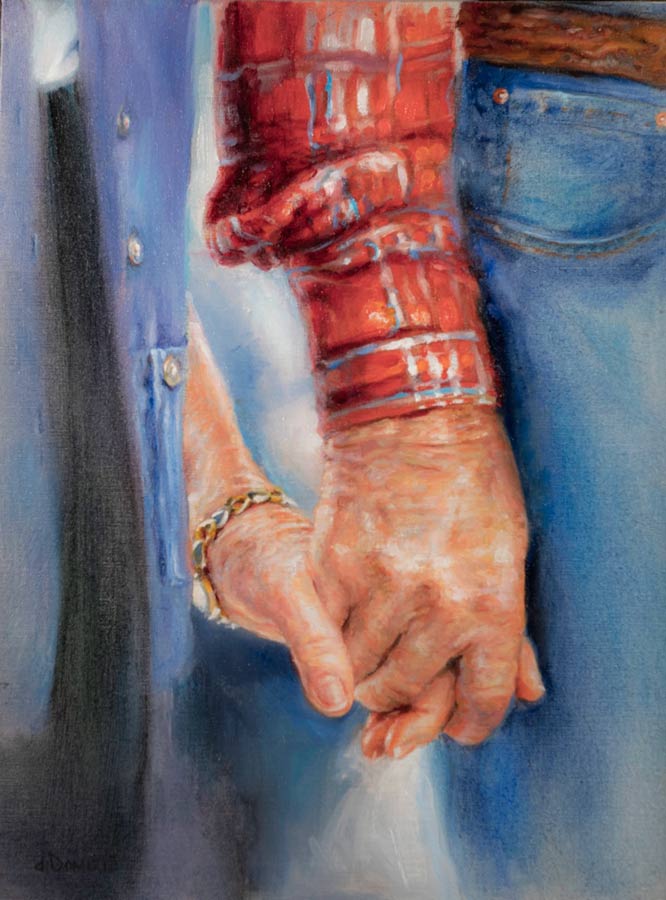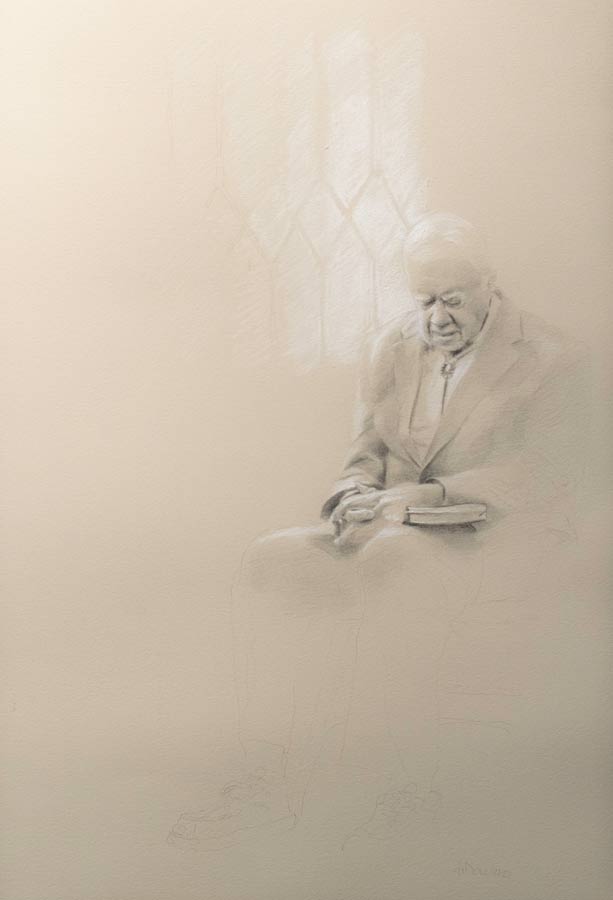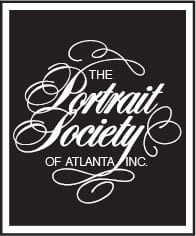by Don Meadows
For much of the past decade, Chris diDomizio has been getting to know President Jimmy Carter. The result has been a legacy series of sketches and paintings presented to the Carter Center and Carter Library, as well as to the National Portrait Gallery.
The project began when Jill Stuckey, Superintendent of the Jimmy Carter National Historical Park in Plains, GA, gave Chris some images of Carter in an effort to generate ideas for portraits of the former U.S. president.
“For me, the images were inspirations to seek to understand a person with a legacy and history that went much deeper than simply images. I could see in the images that President Carter was surrounded by people who had a deep passion for his mission and love for what he stood for last decades, some 20-45 years.”
Stuckey also arranged for Chis to meet and photograph Carter and Rosalynn, his wife.
Chris produced 28 drawings in graphite and charcoal, paintings, and numerous oil sketches before realizing the image he was looking for.
“On our first visit to Plains, GA, we had the honor to meet President Carter and his wife. To say that this was the opportunity of a lifetime would be an understatement. And not because of a shared religious belief system, but because the depth of the images that were shared with me came to life in the conversation.”
As work on the project continued, Chris had numerous conversations and interviews with the people who were central to Carter’s life, including Stuckey. She has known and worked with the Carters personally—even sharing dinner at her house weekly for 30 years.

“Because of our limited time with the President, I chose to interview Jill for 5 hours about her life behind the scenes with President Carter and how she saw him from her perspective,” Chris said.
Practically speaking, we all agreed on the image that would be the hallmark, what the final outcome would ultimately be. But when I finished the first painting, I realized that something was missing.
“For me it was missing the person viewed by his friends. It was missing the emotions of the people that had surrounded the President for a lifetime. So, I continued my search for how to depict the man so loved by so many.”
As his journey continued, Chris sought out more dimensions of President Carter’s life. “Until you understand the joy, the pain, the ups, and the downs, you cannot really understand how to approach the outcome. For that, I needed to talk to another person intricate to the Carter’s life: Rita Thompson.” Thompson spent nearly 45 years working with the Carters in various capacities, beginning as a volunteer with Carter’s 1976 presidential campaign, continuing as a political advisor and family assistant.
“The more I discovered about President Carter the more I understood why they were his lifelong friends. The images began to take form. The pictures that had been initially shared with me started to tell a story that was much deeper than the outcome of a camera sitting in front of the President,” Chris said.
“And embarking on this journey became a sobering moment for me. Telling the ‘Legacy’ of a person with so much depth became more than just about President Carter. It became about creating a portrait that would convey a lifetime of people coalescing together.”
To help organize and clarify his thoughts, Chris started journaling, which he also refers to as “art mapping.” “Journaling about the people that have brought me into their lives to convey a message is something that I started just recently, over the last 10 years.” And throughout this process, I continued to journal – before, during, and after each drawing, sketch, and painting.
Journaling helps Chris determine the desired results for each piece of art he creates. “The journaling started to help me search through various drawings and perspectives; to process what I had heard, to process what I had seen, and to bring a much richer understanding with more depth on the President.”
In the process, Chris found that he also needed to journal about the multiple dimensions of the paintings. In the process. So, he started two journals, one about Rita and Jill’s thoughts, the other about his personal journey and experiences.
“I started searching through various drawings and perspectives. I began to see the photos taken from my first visit to Plains, GA, of President Carter praying in church were closer to what I was after. I believe the Carters have that drawing in their house as well as the painting I did of them holding hands – just their hands,” Chris said. That painting was given to the Carters as a gift for their 75-year wedding anniversary.

While painting someone holding hands feels fairly straight forward, there is a personal component that is much deeper, Chris said. He also wanted to make sure that he provided a sense of place to the series through landscapes from Plains.
“Through this process, I started to see the value and commitment he had toward Rosalynn, his friends, and lifelong commitments for the people he was standing for. And ideas and images for this series began to surface after reading his autobiographies. The biggest revelation was his childhood stand against social injustice (as illustrated in his poem, ‘The Pasture Gate’).”
All told, Chris produced 28 drawings in graphite and charcoal, paintings, and numerous oil sketches before realizing the image he was looking for. “I started to settle on this image, painting it five different times in various sizes (one residing in the Carter Library the other now in the Smithsonian). The President, the man, the husband, the friend, standing alone in his faith and beliefs, against others.”
As he neared completion of the series, Chris realized that there was one more painting to do, which he titled “A Man of God.” The inspiration for this painting was the first photographs Chris and his wife captured of Carter praying by a stained glass window before his bible study class in church. This painting has a gold leaf background, which is already laid, bathing him with God’s light.
A sketch on grey paper is one of two reference drawings used for this painting.
This sketch is in the Carter House and various oil sketches of it are at the Carter Library.
The process of art mapping and the questions as a result of this that were answered by Rita and Jill aided me in capturing the essence of portrait (and drawings). This is their painting of him, by me.
In the art mapping process, the main question is “why is that important to you (them)?” which I asked Jill and Rita. This one question is able to give me clarity on type of brush, size, surface, type of brush strokes, color schemes, lost and found edges, etc. to help me paint their—or more accurately—our painting. Rather than making a decision based on the image, the art mapping tells me more about the depth that is beyond an image and the surface.
Without art mapping, I would not have started painting again and had never had this opportunity.
For me, the process of going deeper into understanding the message that needs to be conveyed far outweighs the theories, tools, and concepts of art. While everything is important. Absent the message, it’s just a replication of what we see with our eyes. It’s just a copy-and-paste of an image.
To learn more about Chris, his approach to art, and the Carter series, watch the YouTube video of the presentation he gave for Portrait Society of Atlanta on March 25, 2021.


